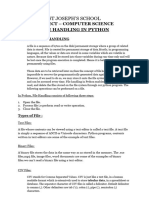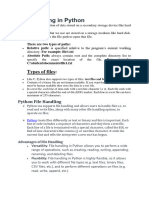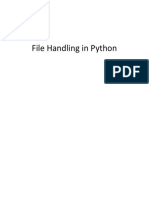Introduction To File Handling
Uploaded by
naveenIntroduction To File Handling
Uploaded by
naveenIntroduction to File Handling :
• Files are nothing but the collection of data.
• Files can be stored on a secondary memory device like hard disks, pen-drives or cds.
• Files are loaded in main memory(hard disk) or ram.
• Once the data is stored in computer file, you can retrieve it and use it as per the requirement
Advantage of storing data in file
File is stored In computer hard disk permanently. Even though computer switched off ,the file
and it’s data is not removed.
It is possible to update, modify the data whenever required.
The stored data can be used by anybody whenever required
eg- A file containing student data can be used by department, office, staff
File can be used to store huge amount of data
eg- voters list, data of all the students in a college
File Path Files are stored in secondary memory.
Each file has a path which helps system to locate the file.
In Windows path starts with drive name. (Ex c:\, d:\).
Example : C:\Users\Gamers>d:
D:\>cd python code
D:\python code>cd Unit 1
D:\python code\Unit 1>addition.py
In Linux or allied operating systems, path starts from root (/) directory. (Ex. /home,/user).
Types of Files Python supports two types of files.
The first one is a text file that store data in the form of text and readable by humans and
computers.
The second one is binary file that store binary data and readable by computer only 1.
1.Text Contents (Text Files) :
Here files have all data which is text.
Text can be stored in various ways.
Simplest files are .txt files Also famous document (.docx) is also text.
Some example formats are :
Text Files (.txt)
Document Files (.docx)
Pdf Files (.pdf)
Database Files (.csv)
2. Binary Contents (Binary Files) :
Here files have binary data.
Various image, video, and audio data can be stored here in binary form.
Reading these files require special handling. Here data stored is processed byte by
byte. Binary
files have various encodings. Encoding enables compressed or uncompressed storage.
Additionally binary files include compressed files.
Compressed files store data in minimal space.
Some example formats are :
Image Files (.jpeg, .png)
Video Files (.mp4)
Audio Files (.mp3)
Compressed Files (.zip, .rar)
Opening and Closing a File (in Python) :
File contents need to be in RAM for accessing.
So, file opening operation gets contents in RAM.
Also opening the file returns a reference to file.
File reference is used in different operations on file.
File reference stores current position to read or write.
There are two ways to open and close the files in python.
File Handling :
Open and Close :
Open file Here Open() function is used to open the file.
This function accepts the ‘filename’ and open mode to open the fileing”
Example: File handler=open(“filename”, ”open mode”, ”buffering”)
F=open(“myfile.txt”,”w”)
F is file handler or file object
myfile.text is the name and type of file.
w is the write-mode in which file is open .
Buffering is the optional temporary integer which sets the size of memory for the
file.
File open Modes & Description
r Opens a file for reading only.
The file pointer is placed at the beginning of the file.
This is the default mode.
r+ Opens a file for both reading and writing.
The file pointer placed at the beginning of the file.
w Opens a file for writing only.
Overwrites the file if the file exists. If the file does not exist, creates a new
file for writing.
w+ Opens a file for both writing and reading.
Overwrites the existing file if the file exists. If the file does not exist, creates
a new file for reading and writing.
a Opens a file for appending.
The file pointer is at the end of the file if the file exists.
That is, the file is in the append mode. If the file does not exist, it creates a
new file for writing.
a+ Opens a file for both appending and reading.
The file pointer is at the end of the file if the file exists.
The file opens in the append mode. If the file does not exist, it creates a new
file for reading and writing.
x To open the file in exclusive creation mode.
The file creation failed if file already exists.
Close file
The file which is open must be closed using close() function/method.
If the file is not closed then data in it may be corrupted or deleted I some cases.
Also the memory occupied by the file is not freed.
File_ref.close()
f.close()
File handling methods
Read()
Write()
Writelines()
Readlines()
List()
Seek()
Tell()
#python program to read and display it’s content
f=open('d:\\test.txt',"r") #open file in read mode
print(f.read()) #read file and display it’s contents
f.close()
# Python code to illustrate read() mode character wise
file = open(" d:\\test.txt ", "r")
print(file.read(6))
f.close()
#python program to Write and display it’s content
file = open(‘d:\\test1.txt ','w')
file.write("This is the write command")
file.write("It allows us to write in a particular file")
file.close()
# Python code to illustrate write() mode character wise
f = open('d:\\test1.txt ','w+')
f.write("This is the write command")
f.write("\n It allows us to write in a particular file")
f.write("\n\n\nPython programming")
f.close()
Seek() and tell() method
Seek method() used to change file pointer position and tell() method returns the current
position of file pointer
file_object.seek(offset[,whence])
• offset − This is the position of the read/write pointer within the file.
• whence − This is optional and defaults to 0 which means absolute file positioning, other
values are 1 which means seek relative to the current position and 2 means seek relative to the
file's end.
#Python program using seek() and tell() methods
F=open(‘d:\\test3.txt’,’r’)
print(“\tthe contents of the file are…”)
print(F.read())
Print(‘the current position of file pointer is: ‘)
Print(F.tell())
F.seek(0)
Print(‘Now the position of file cursor is:’)
Print(F.tell())
You might also like
- Computer Theory Book 3rd Edition (English Medium)No ratings yetComputer Theory Book 3rd Edition (English Medium)253 pages
- File Handling in Python: 18103097 Parijat Garg 18103122 Atul KumarNo ratings yetFile Handling in Python: 18103097 Parijat Garg 18103122 Atul Kumar18 pages
- Python Prog Unit-4 Notes by Kamal Kant TripathiNo ratings yetPython Prog Unit-4 Notes by Kamal Kant Tripathi19 pages
- A High-Level, Interpreted and General-Purpose Dynamic Programming Language That Focuses On Code ReadabilityNo ratings yetA High-Level, Interpreted and General-Purpose Dynamic Programming Language That Focuses On Code Readability15 pages
- Python File Handling Made Easy: A Practical Guide with ExamplesFrom EverandPython File Handling Made Easy: A Practical Guide with ExamplesNo ratings yet
- Create XLSX - MHTML File From Internal Table in BackgroundNo ratings yetCreate XLSX - MHTML File From Internal Table in Background12 pages
- Music (431,022 Results) Page 1 - TorrentQuest PDFNo ratings yetMusic (431,022 Results) Page 1 - TorrentQuest PDF2 pages
- Adobe Acrobat Xi Pro 1109 Multilanguage Chingliu 314 PDFNo ratings yetAdobe Acrobat Xi Pro 1109 Multilanguage Chingliu 314 PDF4 pages
- Optimizing A Torrent For Best Upload Speed/resource Usage. How To Set The Right Piece Size ValueNo ratings yetOptimizing A Torrent For Best Upload Speed/resource Usage. How To Set The Right Piece Size Value14 pages
- File Handling in Python: 18103097 Parijat Garg 18103122 Atul KumarFile Handling in Python: 18103097 Parijat Garg 18103122 Atul Kumar
- A High-Level, Interpreted and General-Purpose Dynamic Programming Language That Focuses On Code ReadabilityA High-Level, Interpreted and General-Purpose Dynamic Programming Language That Focuses On Code Readability
- Python File Handling Made Easy: A Practical Guide with ExamplesFrom EverandPython File Handling Made Easy: A Practical Guide with Examples
- Create XLSX - MHTML File From Internal Table in BackgroundCreate XLSX - MHTML File From Internal Table in Background
- Adobe Acrobat Xi Pro 1109 Multilanguage Chingliu 314 PDFAdobe Acrobat Xi Pro 1109 Multilanguage Chingliu 314 PDF
- Optimizing A Torrent For Best Upload Speed/resource Usage. How To Set The Right Piece Size ValueOptimizing A Torrent For Best Upload Speed/resource Usage. How To Set The Right Piece Size Value

























































































